Did the White House Kill the Record of Judge Roberts’ Views on Affirmative Action?
 Last year during the lead-up to the confirmation hearings for Judge John Roberts as Chief Justice of the United States, it was discovered that a file headed “Affirmative Action” was missing from the White House files stored at the Ronald Reagan Presidential Library. Roberts had worked as a White House aide during the Reagan administration. Last year during the lead-up to the confirmation hearings for Judge John Roberts as Chief Justice of the United States, it was discovered that a file headed “Affirmative Action” was missing from the White House files stored at the Ronald Reagan Presidential Library. Roberts had worked as a White House aide during the Reagan administration.
A report from the National Archives inspector general found that White House aides from the Bush administration visited the Reagan Library to do a background check on Roberts. The report found that the aides were permitted to bring personal items into the library and were left alone at times with the document collection. The report says that the White House aides were the last known people to see the file entitled “Affirmative Action.”
The White House has denied charges that the aides took or destroyed the file.
Number of African Students at U.S. Universities Drops for the Second Year in a Row
In the aftermath of the September 11, 2001 terrorist attacks, it was widely expected that the number of foreign students enrolled at colleges and universities in the United States would decline significantly. But this did not occur, particularly for students from African nations. In 2001 there were 34,217 African students at U.S. colleges and universities. Two years later there were 40,193 students from Africa at American colleges and universities. This was an increase of more than 17 percent.
Now it appears that increased political pressures for homeland security measures have begun to curtail the number of foreign students who are permitted to study at higher educational institutions in this country. In 2005 there were 36,100 African students at American colleges and universities. This is a drop of more than 10 percent in just two years.
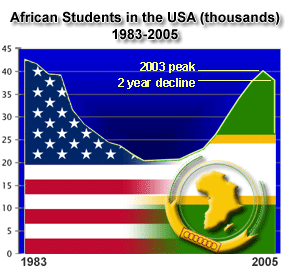
  |
 “Exposure to a ‘redneck’ culture, associated with the American South, where aggression, bluster, idleness and anti-intellectualism are extolled is a prime reason explaining why a vast number of blacks do not embrace education.” “Exposure to a ‘redneck’ culture, associated with the American South, where aggression, bluster, idleness and anti-intellectualism are extolled is a prime reason explaining why a vast number of blacks do not embrace education.”
— Thomas Sowell, Black Rednecks and White Liberals (Encounter Books)
|
Study Finds That Modest Financial Aid Rewards Can Improve Academic Performance and Retention Rates for Low-Income Students
New research from the Manpower Demonstration Research Corporation, a nonprofit organization created by the Ford Foundation, shows how important financial aid scholarships can be in increasing retention for low-income students in higher education.
 The study involved low-income students at two community colleges in Louisiana. While the study does not include racial data, blacks make up large percentages of the total enrollment at both colleges used in the study. Many of the students who participated in the study were single mothers. The study involved low-income students at two community colleges in Louisiana. While the study does not include racial data, blacks make up large percentages of the total enrollment at both colleges used in the study. Many of the students who participated in the study were single mothers.
The students were randomly placed in two groups. One group was eligible for grants totaling $2,000 if they remained enrolled full-time and maintained at least a C grade point average. These grants were in addition to their federal Pell Grants. The other group was not eligible for the additional $2,000 in grants.
The study found that the students in the control group that were eligible for the grants were more apt to stay enrolled full-time, they passed more courses, had higher grades, and dropped courses less often.
The authors of the study conclude that even modest financial incentives can go a long way toward improving low-income students’ success rate in higher education.
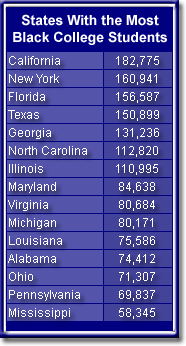 States That Enroll the Most Black Students in Higher Education States That Enroll the Most Black Students in Higher Education
According to new data released by the Department of Education, California has the most African-American students enrolled in higher education. In 2004 there were more than 182,000 black students enrolled in college in California. New York had the second-highest total of blacks enrolled in college with 160,941. Florida jumped ahead of Texas as the state with the third-highest number of African-American college students. In all, there are seven states that have more than 100,000 black students enrolled in college.
On a percentage basis, Mississippi leads the nation. More than 38 percent of all students enrolled in higher education in Mississippi are black. Blacks also make up more than 30 percent of all enrolled college students in Louisiana, Georgia, and the District of Columbia.
University of Arkansas Uses Summer Internship Program to Recruit Black Students for Its Graduate Programs
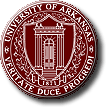 The George Washington Carver Project at the University of Arkansas at Fayetteville has proven to be an effective recruiting tool in bringing African-American graduate students to campus. The six-week summer internship program for undergraduate students at black colleges and universities began in 1997. In addition to seminars and classroom instruction, students work a minimum of 20 hours conducting research with a university faculty member. All expenses are paid and students receive a stipend of $500 per week. The George Washington Carver Project at the University of Arkansas at Fayetteville has proven to be an effective recruiting tool in bringing African-American graduate students to campus. The six-week summer internship program for undergraduate students at black colleges and universities began in 1997. In addition to seminars and classroom instruction, students work a minimum of 20 hours conducting research with a university faculty member. All expenses are paid and students receive a stipend of $500 per week.
The program has grown from two students in 1997 to 30 this year. When the project first began, the University of Arkansas worked with only one black college to bring interns to campus. There are now 22 partner institutions.
About 40 percent of the students who participate in the summer internship program later enrolled in graduate study programs at the university. This recruiting tool has been a major reason why black graduate student enrollments have increased from 35 to 200 over the past several years.
Better Late Than Never: Justice for the Black Man Who Tried to Integrate the University of Southern Mississippi
 Last month JBHE reported on efforts to pardon or overturn the conviction of Clyde Kennard. Kennard was a decorated war hero who in 1956 sought admission to the then all-white University of Southern Mississippi. Kennard was denied enrollment because of his race. But he nevertheless persisted in his efforts to be admitted to the institution. Last month JBHE reported on efforts to pardon or overturn the conviction of Clyde Kennard. Kennard was a decorated war hero who in 1956 sought admission to the then all-white University of Southern Mississippi. Kennard was denied enrollment because of his race. But he nevertheless persisted in his efforts to be admitted to the institution.
Then, in the Jim Crow tradition of severely punishing Negroes who tried to rise above their assigned station, Kennard was accused of receiving $25 of stolen chicken feed. In 1960 he was sentenced to seven years at the notorious Parchman Prison Farm. He died three years later from colon cancer.
Late in 2005 the chief witness in the case against Kennard recanted his testimony and stated that Kennard had been framed. Mississippi governor Haley Barbour admitted that Kennard was innocent but said there was no provision under state law to pardon a man posthumously.
Then, in late May, a group of prominent Mississippians including former governor William Winter and former federal district court judge Charles Pickering petitioned the Forrest County Circuit Court to overturn Kennard’s conviction. Judge Bob Helfrich said that there is no proper vehicle for relief under Mississippi law. Nevertheless, he declared Kennard’s conviction “null and void.”
American Chemical Society

Director, Education
The American Chemical Society seeks a Director of Education to provide vision and leadership for its educational programs, products, and services. The Director of Education defines long-range goals, identifies strategic priorities, recommends policies, develops objectives for future ACS educational efforts, and secures the fiscal resources for their implementation, in accordance with ACS policies. This involves promoting high-quality chemistry and science education programs throughout the educational spectrum and developing initiatives to attract students to, and prepare them for, rewarding careers in the chemical and allied sciences. The Director is responsible for collaborating with professional organizations in the U.S. and internationally in order to facilitate information exchange and enhance the quality of educational programs. The Director works closely with the volunteer leadership of ACS—the Society Committee on Education, the Committee on Professional Training, and other committees—to ensure excellence in chemical education, coordinates with other Society governance and operational units on education issues, and manages the staff of the Education Division.
A Ph.D. degree in chemistry or chemistry-related disciplines, chemical engineering, or chemistry education; a minimum of 12 years of senior level experience in the chemical sciences, education, and management of the chemical sciences or education; and a record of acclaimed scientific/engineering accomplishment are preferred. The ideal candidate will have an understanding of education policy and assessment issues, and their relationship to educational design and implementation across the entire educational spectrum. The applicant will be a creative thinker; a passionate and effective communicator; a strategic leader; comfortable with the big-picture; forward-looking; bold; capable of developing and pursuing an innovative vision for influencing how chemistry is taught; experienced working in a high-energy and visible position; and capable of understanding, working with, listening to, and building consensus and collaboration across diverse constituencies, both within and outside ACS.
ACS is a federally chartered, non-profit organization with a multidisciplinary membership of more than 158,000 chemists, chemical engineers, and allied professionals. It publishes numerous educational and scientific journals, magazines, books and databases, convenes major research conferences and provides educational, science policy and career programs in chemistry and related fields. ACS offers an excellent salary and benefits package. Please visit our website at www.chemistry.org for additional position information. Please submit a cover letter and résumé to employment@acs.org, or mail to 1155 16th Street, NW, Washington DC 20036, Attn: Human Resources. Applications received by June 30 will receive priority attention.
Join ACS and help us pursue our vision: “Improving people’s lives through the transforming power of chemistry.”
ACS is a drug free/smoke free, equal opportunity employer.
Appointments
 • Terri Harris Reed has been promoted to vice provost for institutional equity and diversity at Princeton University. She was the associate provost. • Terri Harris Reed has been promoted to vice provost for institutional equity and diversity at Princeton University. She was the associate provost.
Reed is a graduate of Calvin College and holds a master’s degree from the Harvard Graduate School of Education. She is currently pursuing her Ph.D. in communications from Howard University.
 • Charlotte H. Johnson was named vice president and dean of the college at Colgate University in Hamilton, New York. Johnson was the assistant dean for student affairs at the University of Michigan School of Law. • Charlotte H. Johnson was named vice president and dean of the college at Colgate University in Hamilton, New York. Johnson was the assistant dean for student affairs at the University of Michigan School of Law.
A native of Birmingham, Alabama, Johnson was the valedictorian of her graduating class at the University of Detroit. She went on to earn a law degree from the University of Michigan.
 • Luther S. Williams was named provost and vice president for academic affairs at Tuskegee University. He was dean of graduate studies and director of a Ph.D. program in the biological sciences at Tuskegee. • Luther S. Williams was named provost and vice president for academic affairs at Tuskegee University. He was dean of graduate studies and director of a Ph.D. program in the biological sciences at Tuskegee.
Williams is a graduate of Miles College. He holds a master’s degree from Atlanta University and a Ph.D. in microbial physiology from Purdue University.
 • Darlyne Bailey was appointed dean of the College of Education and Development at the University of Minnesota. Bailey will be the first African-American female dean at the university. For the past four years Bailey has been vice president for academic affairs and the dean of the Teachers College at Columbia University. • Darlyne Bailey was appointed dean of the College of Education and Development at the University of Minnesota. Bailey will be the first African-American female dean at the university. For the past four years Bailey has been vice president for academic affairs and the dean of the Teachers College at Columbia University.
Bailey holds a master’s degree in psychiatric social work from Columbia University and a doctorate in organizational behavior from Case Western Reserve University.
• David T. Terry, an instructor in history and African diaspora studies at Morgan State University in Baltimore, was named executive director of the Reginald F. Lewis Museum of Maryland African-American History & Culture.
|
Snail-Like Progress in Increasing Black Full-Time Faculty in Higher Education
New data from the U.S. Department of Education reports that in 2004 there were 33,137 black full-time faculty members at degree-granting institutions in the United States. They made up 5.4 percent of the more than 610,000 full-time faculty members at these institutions.
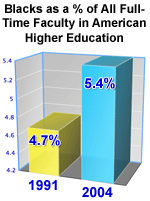 There has been snail-like progress in increasing the black percentage of full-time faculty at U.S. institutions of higher education. Fifteen years ago in 1991, blacks were 4.7 percent of all full-time faculty. At this rate of improvement, it would take nearly two centuries for the black percentage of full-time faculty to equal the black percentage of the U.S. population. There has been snail-like progress in increasing the black percentage of full-time faculty at U.S. institutions of higher education. Fifteen years ago in 1991, blacks were 4.7 percent of all full-time faculty. At this rate of improvement, it would take nearly two centuries for the black percentage of full-time faculty to equal the black percentage of the U.S. population.
Black women made up 51 percent of all African-American full-time faculty members. White women made up just 39 percent of white full-time faculty.
Black representation in faculty ranks grows smaller at the highest levels of faculty positions. Blacks are 6.6 percent of the assistant professors and 7.4 percent of the instructors but only 3.2 percent of the full professors.
Black women are only 36 percent of all African-American full professors but 54 percent of the assistant professors and 58 percent of the instructors.
No Improvement in Black Faculty Levels at the University of California
A new report from the Task Force on Faculty Diversity at the University of California finds that there has been an increase in the total number of black and other minority faculty on the system’s campuses. But the percentage of black faculty has remained stagnant since the passage of Proposition 209 in 1996. This public referendum not only bans race-sensitive student admissions at the University of California but also prohibits the use of race as a factor in hiring decisions for faculty positions.
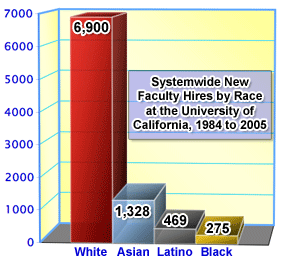
The data shows that from 1984 to 2005 there have been 9,021 appointments to faculty positions at the University of California’s campuses. Of these, 275, or 3 percent, have been black. In the latest year, there were 20 black faculty appointments systemwide at the University of California. They made up 3.7 percent of the 542 faculty appointments.
At the flagship campus of the University of California at Berkeley, 48 blacks have been named to the faculty in the 1984 to 2005 period. They made up 3.5 percent of the 1,365 appointments made in that period.
The study also found that black and other minority faculty members are concentrated in the humanities and social sciences and almost nonexistent in many scientific fields. The report found that the number of black faculty on many campuses is so low that African-American scholars often develop a sense of isolation and marginalization in their academic experiences.
Racial Makeup of High School Guidance Counselors
High school guidance counselors play a major role in a student’s decision as to whether or not to apply to college. For those students who do plan on college, high school counselors often have a major influence on a student’s decision as to the institutions that should be considered.
 The annual report State of College Admission, from the National Association for College Admission Counseling, finds that 7.3 percent of high school guidance counselors in the United States are African Americans. In the South, blacks are 15.5 percent of the counselors. About 9 percent of all counselors in the Middle Atlantic and Midwestern states are black. The annual report State of College Admission, from the National Association for College Admission Counseling, finds that 7.3 percent of high school guidance counselors in the United States are African Americans. In the South, blacks are 15.5 percent of the counselors. About 9 percent of all counselors in the Middle Atlantic and Midwestern states are black.
Black guidance counselors are more common in high schools with large numbers of poor students. At high schools where more than 75 percent of all students qualify for federal programs for free or reduced price lunches, 27 percent of all guidance counselors are black. Yet in these schools, many of which are predominantly black or Hispanic, more than two thirds of all guidance counselors are white.
African-American Students at the Six Law Schools at Historically Black Universities
In the 2004-05 academic year there were 9,488 black students attending the 188 U.S. law schools accredited by the American Bar Association. Blacks now make up 6.4 percent of all law school enrollments, a decrease from 6.8 percent of the total enrollments two years ago.
While African-American students are finding it increasingly difficult to gain admission to the nation’s highest-ranked law schools, the six law schools at historically black universities offer the only educational alternative for many aspiring black lawyers. The six law schools are at Howard University, North Carolina Central University, Southern University, Texas Southern University, the University of the District of Columbia, and Florida A&M University.
Today these six law schools enroll nearly 2,700 students of all races. The black percentage of total enrollments at these schools range from a high of 79.8 percent at Howard University to a low of 30.6 percent at the University of the District of Columbia. In fact, blacks are a majority of all students at only two of the six law schools on HBCU campuses.
Nevertheless, all six schools are providing legal education to large numbers of black students. It is important to note too that all six law schools are highly selective. All six accept less than one third of all students who apply for admission.
  |
20.3% Percentage of all 18- to 24-year-old African Americans who were enrolled in higher education in 1984.
31.8% Percentage of all 18- to 24-year-old African Americans who were enrolled in higher education in 2004.
source: U.S. Bureau of the Census
|
Morehouse College Graduates Its Largest Class in History
 Readers of JBHE are well aware of the fact that black women hold a large lead over black men in college enrollments, degrees earned, honor roll achievement, and just about every facet of higher education. Readers of JBHE are well aware of the fact that black women hold a large lead over black men in college enrollments, degrees earned, honor roll achievement, and just about every facet of higher education.
But Morehouse College in Atlanta remains a powerful beacon of achievement in the higher education of black men. Morehouse, the alma mater of Martin Luther King Jr., is a highly selective liberal arts institution with one of the highest graduation rates among the nation’s historically black colleges and universities. This spring 540 black men graduated from Morehouse College, the largest class in the 139-year-old history of the institution.
Morehouse is one of only four colleges in the United States that restricts enrollments to men.
At the University of Texas at Arlington, Black Faculty Are Hard to Find
 More than 13 percent of the 19,000-member student body at the University of Texas at Arlington is black. But there are only six tenured black faculty members at the institution and five other blacks holding tenure-track positions. Blacks make up less than 2 percent of all faculty. The history department is the only one in the university to have more than one black faculty member. Associate Professor Myrtle Bell is the only black faculty member at the university’s college of business. Professor Dereje Agonafer is the only black faculty member in the College of Engineering. More than 13 percent of the 19,000-member student body at the University of Texas at Arlington is black. But there are only six tenured black faculty members at the institution and five other blacks holding tenure-track positions. Blacks make up less than 2 percent of all faculty. The history department is the only one in the university to have more than one black faculty member. Associate Professor Myrtle Bell is the only black faculty member at the university’s college of business. Professor Dereje Agonafer is the only black faculty member in the College of Engineering.
Furthermore, a decade ago there were at least 17 black faculty members on campus, nearly 55 percent more than is the case today. Last fall there were 45 new faculty members on campus. Only one was black.
Whites Have Become the Heavy Hitters in Black College Baseball
-1.gif) A generation ago African Americans made up close to one quarter of the players in Major League baseball. Today only 8.5 percent of the players on Major League rosters are African Americans. A generation ago African Americans made up close to one quarter of the players in Major League baseball. Today only 8.5 percent of the players on Major League rosters are African Americans.
At the college level, about 6 percent of the players on baseball athletic scholarships are black. But many of the nation’s best college baseball teams have no black players.
Now, white players have become the norm on the baseball teams at the nation’s historically black colleges and universities. Of the seven black colleges in the Mid-Eastern Athletic Conference which field baseball teams, only one has a roster where the majority of its players are black. Blacks make up about 90 percent of the overall student bodies at these schools. At Coppin State University in Baltimore, half of the white males in the overall student body are baseball players.
Baseball coaches at the black colleges say that they try to recruit the best overall talent available and that there are not large numbers of African-American prospects. The best black baseball players either turn professional or are recruited with full athletic scholarships by the nation’s top college baseball programs.
Norfolk State Receives Its Largest Donation in History
 Norfolk State University, the historically black, publicly operated university in Virginia, received a $1 million donation from Ernest Hodge, a 1975 graduate of the institution. The donation is the largest in the history of the university. Norfolk State University, the historically black, publicly operated university in Virginia, received a $1 million donation from Ernest Hodge, a 1975 graduate of the institution. The donation is the largest in the history of the university.
Hodge, who earned a bachelor’s degree in business and marketing from Norfolk State, became a car salesman. He established his first dealership in 1991 and now owns Cadillac, Honda, and Lexus dealerships in Florida, Ohio, and Connecticut.
Norfolk State will use the money to establish a center for entrepreneurship at its School of Business.
In Memoriam
Katherine Dunham (1909-2006)
 Katherine Dunham, one of the nation’s most accomplished choreographers and teachers of dance, has died at the age of 96. Katherine Dunham, one of the nation’s most accomplished choreographers and teachers of dance, has died at the age of 96.
A native of Joliet, Illinois, Dunham earned a bachelor’s, master’s, and doctoral degree in anthropology at the University of Chicago. In 1931 she established her first school of dance in Chicago where she developed advanced methods for teaching dance, which are still used today all over the world. Her Katherine Dunham Troupe performed more than 100 works of original dance, all choreographed by Dunham. Later in her career, she joined the faculty at Southern Illinois University.
Throughout her career Dunham also was a strong advocate for civil and human rights. In 1982 at the age of 73, Dunham went on a 47-day hunger strike to protest the U.S. policy of deporting refugees from the political turmoil in Haiti.
While in her nineties, Dunham still taught dance at college seminars even though she was confined to a wheelchair.
Harrison Allen Jr. (1928-2006)
Harrison Allen Jr., a chemical engineer who was a major force behind efforts by NASA to recruit more students at black colleges and universities for careers in science and technology, died last month. He was 78 years old.
Raised by a single mother, Allen attended Cleveland’s East Technical High School and went on to earn a bachelor’s degree in chemical engineering from what is now Cleveland State University.
As a NASA research scientist, Allen was the inventor of the process used to ignite solid fuel propellants in the Apollo moon program and for the booster rockets on the space shuttle. As an administrator at NASA’s Lewis Research Center in Cleveland, Allen spent a great deal of time visiting high schools and colleges in an effort to encourage more black students to consider careers in science. He also headed up NASA’s research grant program directed at historically black colleges and universities.
Awards
• Dolph Pulliam, director of community outreach and development at Drake University, and Carlie Tartakov, a professor of multicultural education at Iowa State University, were inducted into the Iowa African-American Hall of Fame.
Grant
• South Carolina State University, the historically black educational institution in Orangeburg, received an $865,000 grant from the U.S. Department of Transportation’s Research and Innovative Technology Administration. The grant will be used to conduct research and educational programs on finding practical applications for technology in transportation systems.
|

